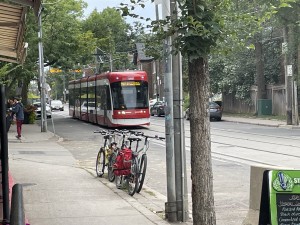Toronto’s bike plan is in place. It just needs to be implemented
Mayor Chow doesn’t need to reinvent the bicycle wheel, she only needs to translate they city’s existing cycling plan into action.
Cycling targets and priorities were already articulated in the city’s bike and road safety plans during the tenure of Mayor Olivia Chow’s predecessor. In fact, our mayor doesn’t need to reinvent the bicycle wheel; she only needs to translate existing plans into action.
Toronto has changed dramatically since 2001, when then Councillor Chow was the chair of the now defunct City Cycling Committee. At the time, Council passed an ambitious, but ultimately ill-fated, 10-year bike plan, “Shifting Gears.” The plan envisioned a citywide grid of 500 kilometres of bike lanes, supplemented by 500 kilometres of designated bike routes and off-road trails. At the end of 2010, most of that plan remained on paper. Under subsequent mayors Rob Ford and John Tory action on cycling infrastructure remained listless — at least until the global pandemic.
Today, the number of city residents who cycle for utilitarian purposes — to go to school, work, shop, or visit — has jumped to more than one million people, according to a 2019 Nanos survey for city hall. In 2001, that number stood at less than 400,000. Other developments are pumping up cycling numbers: electric bikes have proliferated, improving the range and ease of travel, while food delivery by bike has surged. Bike Share continues its rapid expansion.
The City of Toronto’s capital budget for cycling has grown to $20 million annually while political support for bikeways now extends far beyond the downtown. A recent council debate about extending the Bloor bike lane into Etobicoke, for example, passed by a 22-to-1 vote. Meanwhile, the staff complement for the city’s cycling and pedestrian unit has increased to 30, compared to four individuals in 2001.
Perhaps most importantly, city hall finally appears to appreciate cycling as a key element of our transportation system and the climate action strategy, instead of as a perk for cycling “enthusiasts.”
In short, Mayor Chow mainly needs to harness public support, demand, and excitement for cycling to ensure that the current bike plan target of 33 kilometres of new bike lanes each year is achieved. The result, by the end of her first term, would be to add well over 100 kilometres of new bike lanes to a cycling system that today covers about 200 kilometres (a mere four per cent) of Toronto’s 5,600-kilometre road network.
The key for the mayor will be to ensure that the current backsliding in bike plan targets since 2020 — when 30 kilometres of bike lanes were installed — doesn’t become a pattern. Last year less than 13 kilometres were installed, and in 2021 only 20 kilometres.
In short, Mayor Chow cannot only have an easy ride on her two-wheeled way to work each day but also on the cycling file, simply by continuing along the path already laid out for her.
Albert Koehl is an environmental lawyer, and a founder of Community Bikeways.
